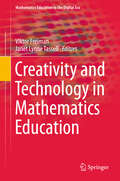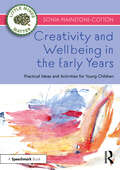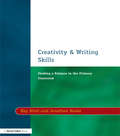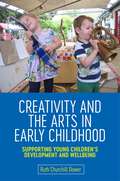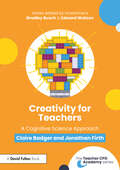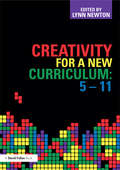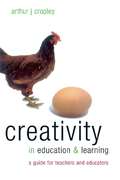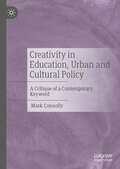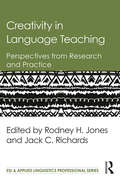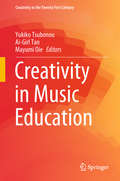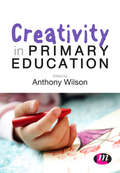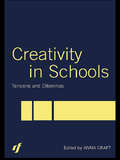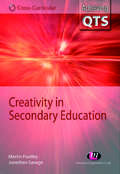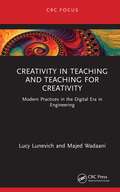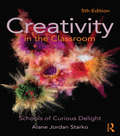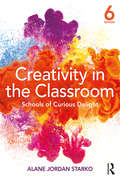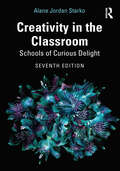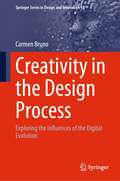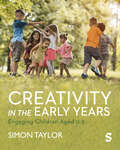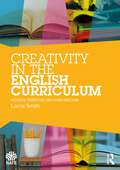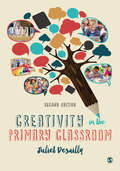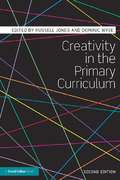- Table View
- List View
Creativity and Technology in Mathematics Education (Mathematics Education in the Digital Era #10)
by Viktor Freiman Janet Lynne TassellThis volume provides new insights on creativity while focusing on innovative methodological approaches in research and practice of integrating technological tools and environments in mathematics teaching and learning. This work is being built on the discussions at the mini-symposium on Creativity and Technology at the International Conference on Mathematical Creativity and Giftedness (ICMCG) in Denver, USA (2014), and other contributions to the topic. The book emphasizes a diversity of views, a variety of contexts, angles and cultures of thought, as well as mathematical and educational practices. The authors of each chapter explore the potential of technology to foster creative and divergent mathematical thinking, problem solving and problem posing, creative use of dynamic, multimodal and interactive software by teachers and learners, as well as other digital media and tools while widening and enriching transdisciplinary and interdisciplinary connections in mathematics classroom. Along with ground-breaking innovative approaches, the book aims to provide researchers and practitioners with new paths for diversification of opportunities for all students to become more creative and innovative mathematics learners. A framework for dynamic learning conditions of leveraging mathematical creativity with technology is an outcome of the book as well.
Creativity and Wellbeing in the Early Years: Practical Ideas and Activities for Young Children (Little Minds Matter)
by Sonia Mainstone-CottonThis accessible and practical guide explores how we can enhance and embed creativity in the early years to support children’s wellbeing. The book initially explores the work of Anna Craft, Ken Robinson, and Reggio Emilia to think about creativity with young children, before considering what this means for wellbeing. Five core chapters focus on creative mediums – drawing, sculpting and painting; craft; music; dance and drama; and storytelling and poetry – and offer a range of practical ideas and activities to use and adapt. This book provides: A wide range of activities accompanied by examples of collaborative arts projects with children. Interviews with artists and practitioners who support children’s wellbeing using creative mediums. Recommendations for creative activities using accessible and everyday materials. Case studies showing the positive impact of creativity, from developing children’s cultural understanding to soothing and supporting children with sensory experiences. Suggestions for enthusing children with a love of words, enabling them to express their thoughts and feelings through creative language. Moments for reflection to encourage readers to pause and consider the impact of creativity on their own wellbeing as well as the wellbeing of children in their care. With ideas included that every practitioner can use in their setting, this book is an essential tool for early years professionals who want to build their confidence in using creativity in their practice whilst supporting children’s wellbeing.
Creativity and Writing Skills: Finding a Balance in the Primary Classroom
by Kay Hiatt Jonathan RookeTeachers, trainees and learning support assistants will find this lively and accessible book combines creativity with skills teaching to stimulate and improve children's writing, both at foundation and primary levels. Based on the concepts and objectives of the National Literacy Strategy (NLS), the content is well founded in experience, research and classroom application. Special features include advice on planning, linking to NLS objectives, and selecting texts; demonstration scripts for teachers to use in the classroom; annotated extracts from quality literature to help children read as writers; practical advice on strategies to use in guided writing; and examples of children's work that show how to assess the children's writing and set 'next step' targets. The authors show how you can use drama techniques, story stacks, artifacts and scenarios to engage children in writing, both in fiction and non-fiction, right across the curriculum.
Creativity and Writing: Developing Voice and Verve in the Classroom
by Kathy Goouch Andrew Lambirth Teresa GraingerThis clear yet authoritative book affirms the vital role of creativity in writing and considers and encourages flexible, innovative practices in teaching. Importantly, the book reflects upon teachers' imaginative and artistic involvement in the writing process as role models, collaborators, artists, and as writers themselves. Arguing that children's creative use of language is key to the development of language and literacy skills, this book focuses on the composition process and how children can express their own ideas. In addition, the authors consider the many forms of creative language that influence the inner and outer voice of children, including reading, investigating, talking and engaging in a range of inspiring activities. Illustrated throughout with many examples of children's writing and drawing, this book also provides suggestions for classroom activities and is a source of inspiration and practical guidance for any teacher looking to deepen their understanding of literacy theory and practice.
Creativity and the Arts in Early Childhood: Supporting Young Children’s Development and Wellbeing
by Ruth Churchill Churchill DowerOffering practical guidance on encouraging creativity in early childhood settings, this much-needed book highlights the importance of the arts and creativity for children's learning, critical thinking, social interaction and self-regulation.The book considers the impact of creativity on early brain development and discusses how to choose the right arts or creative approach for your children. Principles for creative curriculums, teaching, assessments and environments are provided and each chapter includes a 'practitioner toolkit' element, with reflective questions and practical strategies for implementing the learning from the chapter into daily practice.
Creativity for Teachers: A Cognitive Science Approach (The Teacher CPD Academy)
by Claire Badger Jonathan FirthCreativity is a word that is widely used in education, but in ways that are not always consistent or in line with research. This exciting new book explores how creativity is not something additional, but which is infused throughout learning, relevant to every subject and student.Taking a cognitive science approach, it presents creativity in terms of building competencies. It challenges the view that schools kill creativity or that only some types of tasks count as creative. By setting up existing lessons in ways that involve more flexibility and uncertainty, we can both boost creativity and build a more flexible academic expertise along the way. Featuring practical classroom examples, research evidence, and case studies which will guide practitioners and provide a timely antidote to stale skills vs. knowledge arguments, the chapters include: Cognitive science and creativity Creativity across subject disciplines Linking creativity and knowledge Freedom vs. constraints Expertise and metacognition Assessing creativity Motivation and school culture Creative teachers and creative teaching Part of The InnerDrive Teacher CPD Academy series that offers a deep dive into the key areas that matter to teachers, this is essential reading for all teachers and school leaders wanting to develop their understanding of what creativity looks like in the classroom so they can better support their students.
Creativity for a New Curriculum: 5-11
by Lynn D NewtonCreativity for a New Curriculum: 5-11 provides an account of what creativity really means in the context of children’s learning in the primary school, and describes in practical terms what teachers can do to foster it. At a time of curriculum development and change, it focuses on the opportunity to build a new curriculum that is inclusive of creativity and is fit for the twenty-first century. The value of fostering creative thinking and problem solving abilities in education is widely recognised for its capacity to confer an independence and ability to function effectively in life. As such, encouraging children to be creative thinkers and problem solvers should be an integral part of everyday teaching and learning across all subjects. Building upon the research and practices of a group of educators studying creativity across the curriculum and coordinated by the author, this book provides primary teachers and trainee teachers with easy to understand explanations of what creativity means in the context of the subjects of the curriculum for young children. It introduces ideas for how to nurture and support it, and explores issues associated with fostering it, such as assessment. Chapters cover areas including: A brief history of creativity and pedagogy, including common misconceptions Strategies for creative learning as well as creative teaching Creativity in English Creativity in Mathematics Creativity in Science and Design and Technology Creativity in Art and Music Creativity in History and the Humanities Creativity in ICT International perspectives on creativity Creativity for a New Curriculum: 5-11 is an ideal source of information for teachers, teacher trainers, students on teaching programmes and anyone interested in developing opportunities for creativity across the primary school curriculum.
Creativity in Education and Learning: A Guide for Teachers and Educators
by Arthur J. CropleyA study of creativity in the context of education, an issue of great importance for teachers and students alike. It considers just how creativity "works" and how it can be encouraged. The book has an international and an historical sweep, and features many examples.
Creativity in Education, Urban and Cultural Policy: A Critique of a Contemporary Keyword
by Mark ConnollyThis book critiques creativity as a ‘keyword’ in contemporary society. This is illustrated through an analysis of the uses of creativity within cultural, urban and educational policy. While there have been critiques and debates of the uses of creativity within these fields, the author innovatively bridges these disciplines by providing both an overview of the philosophical and ideological underpinnings of these debates and illustration of how they manifest in these distinct, yet interrelated policy spheres. Drawing on Raymond Williams’ theory of culture as social communication and keyword approach, the book illustrates how the creative turn in contemporary policy can divert attention from structural analysis and provide a rhetorical gloss for inequitable social policies. It will appeal to academics, students and practitioners involved in education, cultural and urban studies.
Creativity in Language Teaching: Perspectives from Research and Practice (ESL & Applied Linguistics Professional Series)
by Jack C. Richards Rodney H. JonesCurrent, comprehensive, and authoritative, this text gives language teachers and researchers, both a set of conceptual tools with which to think and talk about creativity in language teaching and a wealth of practical advice about principles and practices that can be applied to making their lessons more creative. Providing an overview of the nature of creativity and its role in second language education, it brings together twenty prominent language teachers and researchers with expertise in different aspects of creativity and teaching contexts to present a range of theories on both creative processes and how these processes lead to creative practices in language teaching. Unique in the field, the book takes a broader and more critical look at the notion of creativity in language learning, exploring its linguistic, cognitive, sociocultural and pedagogic dimensions. Structured in four sections— theoretical perspectives, creativity in the classroom, creativity in the curriculum, and creativity in teacher development—each chapter is supplemented by Questions for Discussion and Suggestions for Further Research. Its accessible style makes the book relevant as both a course text and a resource for practicing teachers.
Creativity in Music Education (Creativity In The Twenty First Century Ser.)
by Ai-Girl Tan Yukiko Tsubonou Mayumi OieThis book creates a platform for music educators to share their experience and expertise in creative music teaching and learning with the international community. It presents research studies and practices that are original and representative of music education in the Japanese, Asian and international communities. It also collects substantial literature on music education research in Japan and other Asian societies, enabling English-speaking readers to access excellent research and practical experiences in non-English societies.
Creativity in Primary Education (Achieving QTS Series)
by Dr Anthony Wilson"An alien spaceship crash landed in my playground today" For one primary school in England, this was not an ordinary day. It was a fabulous day of inspiration, writing, drawing, discovering and learning for the pupils, the staff and the parents. But the best thing of all? The only truly out of the ordinary thing was the alien spaceship. So how do you make creativity a more everyday part of primary teaching? Teachers and trainees agree that creativity is a fabulous thing. But to get creative approaches into everyday teaching, you need to tackle the question - what is creativity? This book explores this question in an accessible and practical way. It helps trainees to do more than 'know it when they see it', by helping them to understand the separate and very diverse elements of creativity. The third edition of this popular text retains key material, but it has been updated and revised to include two new chapters on the creative curriculum, along with links throughout to the Standards and the new National Curriculum. This book will help you enhance your teaching so you and the children in your class can be: fellow explorers, adventurous discoverers and spontaneous investigators!
Creativity in Schools: Tensions and Dilemmas
by Anna CraftCreativity in schools is changing, with greater emphasis being placed on creative skills across the curriculum than ever before. This shift has thrown up some challenging questions which this book tackles head-on in order to better understand the implications of this change and the effects on pedagogy and policy. The questions raised include: What is creative learning? How does it relate to creative teaching? How do we organize the curriculum to nurture creativity? What pedagogical strategies support creativity? How is creative learning different to effective learning? What responsibilities do schools have for stimulating creativity in relation to society, ethics and the wider environment? Laying out the key concepts in the current debate on creativity and placing them in a broader context based on practice, policy and research, this volume sets the agenda for future discussion and suggests practical ways to encourage pupils’ creative development in a new and more thoughtful way.
Creativity in Secondary Education (Achieving QTS Cross-Curricular Strand Series)
by Martin Fautley Jonathan SavageCreativity is increasingly seen as central to good learning and teaching throughout the curriculum. This book examines the political and educational context behind such developments and looks at dilemmas faced by trainee teachers as they begin their teaching practice. Demonstrating what creativity is, how it evolves and how it can be nurtured in various teaching contexts, it enables trainees to develop creativity in their teaching role and in their pupils′ learning. Throughout, the book links clearly to the new Professional Standards for QTS and presents exercises, subject-based case studies and teaching examples to engage and support all secondary trainees.
Creativity in Teaching and Teaching for Creativity: Modern Practices in the Digital Era in Engineering
by Lucy Lunevich Majed Rabhan WadaaniIn this book, the authors write about creativity in teaching and how to enhance creativity in learners. They highlight the new reality of teaching and learning in the digital era, specifically the impact of artificial intelligence, data economy, and artificial minds on modern teaching practices, curriculum design, and the role of teachers in classrooms. Creativity in Teaching and Teaching for Creativity: Modern Practices in the Digital Era approaches human intelligence as a universal gift. It emphasizes that the creativity of human beings is not only a natural quality, but one that can be enhanced as a result of learning. The book suggests new teaching models and approaches and discusses how the role of teachers in the classroom has fundamentally changed, emphasizing the emotional connection between students and teachers. The book will find interest among higher education policymakers who believe in the transformation of the education industry, research scholars who are pursuing their Ph.D. in the fields of education technology and education and learning, as well as those working in the area of education technology and artificial intelligence.
Creativity in the Classroom: Schools of Curious Delight
by Alane Jordan StarkoCreativity in the Classroom, Fifth Edition, helps teachers apply up-to-date research on creativity to their everyday classroom practice. Early chapters explore theories of creativity and talent development, while later chapters focus on practice, providing plentiful real-world applications-- from strategies designed to teach creative thinking to guidelines for teaching core content in ways that support student creativity. Attention is also given to classroom organization, motivation, and assessment. New to this edition: * Common Core State Standards--Updated coverage includes guidelines for teaching for creativity within a culture of educational standards. * Technology--Each chapter now includes tips for teaching with technology in ways that support creativity. * Assessment--A new, full chapter on assessment provides strategies for assessing creativity and ideas for classroom assessment that support creativity. * Creativity in the Classroom Models--New graphics highlight the relationships among creativity, learning for understanding, and motivation. The 5th edition of this well-loved text continues in the tradition of its predecessors, providing both theoretical and practical material that will be useful to teachers for years to come.
Creativity in the Classroom: Schools of Curious Delight
by Alane Jordan StarkoCreativity in the Classroom, sixth edition, helps teachers link creativity research and theory to the everyday activities of classroom teaching. This foundational textbook is relevant for any course dealing wholly or partially with creativity and teaching. The sixth edition has been revised and updated throughout, informed by cutting-edge research on neurobiology, curiosity and imaginative play, questioning, and motivation, particularly the relationships among creativity, intrinsic motivation, and motivation to learn.
Creativity in the Classroom: Schools of Curious Delight
by Alane Jordan StarkoNow in its seventh edition, Creativity in the Classroom helps teachers link creativity research and theory to the everyday activities of classroom teaching. Ideal reading for any course dealing wholly or partially with creativity and teaching, this foundational textbook covers definitions, research, and theory in the first half, and reflects on classroom practices in the second. Thoroughly revised and updated, the seventh edition features new research on neuroscience and creativity in specific disciplines; new sections on social-emotional learning, teaching engineering, and leadership; and an entire new chapter on building creativity at the school or district level.
Creativity in the Design Process: Exploring the Influences of the Digital Evolution (Springer Series in Design and Innovation #18)
by Carmen BrunoThe book provides an open and integrated view of creativity in the 21st century, merging theories and case studies from design, psychology, sociology, computer science and human-computer interaction, while benefitting from a continuous dialogue within a network of experts in these fields. An exploratory journey guides the reader through the major social, human, and technological changes that influence human creative abilities, highlighting the fundamental factors that need to be stimulated for creative empowerment in the digital era. The book reflects on why and how design practice and design research should explore digital creativity, and promote the empowerment of creativity, presenting two flexible tools specifically developed to observe the influences on multiple level of human creativity in the digital transition, and understand their positive and negative effect on the creative design process. An overview of the main influences and opportunities collected by adopting the two tools are presented with guidelines to design actions to empower the process for innovation.
Creativity in the Early Years: Engaging Children Aged 0-5
by Simon TaylorThis book offers an accessible and comprehensive new introduction to the subject and practise of creativity in early years education. Taylor takes a uniquely rights-based and inclusive approach to creativity, providing students with a holistic, internationally-minded overview of creativity and its place both inside and outside the classroom. Sections focus on: Defining creativity and its benefits Different modes of creativity Creativity in a policy and social context Creative pedagogy in practice Creative leadership Each chapter offers questions for critical reflection, illustrative contemporary case studies, and ample suggestions for further reading.
Creativity in the Early Years: Engaging Children Aged 0-5
by Simon TaylorThis book offers an accessible and comprehensive new introduction to the subject and practise of creativity in early years education. Taylor takes a uniquely rights-based and inclusive approach to creativity, providing students with a holistic, internationally-minded overview of creativity and its place both inside and outside the classroom. Sections focus on: Defining creativity and its benefits Different modes of creativity Creativity in a policy and social context Creative pedagogy in practice Creative leadership Each chapter offers questions for critical reflection, illustrative contemporary case studies, and ample suggestions for further reading.
Creativity in the English Curriculum: Historical Perspectives and Future Directions (National Association for the Teaching of English (NATE))
by Lorna SmithCreativity in the English Curriculum is essential reading for anyone involved or interested in the teaching of English, offering both a detailed history of how creativity has informed the tradition of teaching English, and how it should be used to position this teaching in the future. Highlighting the need to promote creativity as a rich, intellectual pursuit, Creativity in the English Curriculum celebrates artistry in English past and present, and argues for its restoration to the curriculum. It emphasises that creativity is at the core of a humane education, not only through stimulating and enhancing the growth of the individual, but also through developing understanding of the importance of community, society and collaboration. Smith presents the historical relationship between curriculum policy and creativity, demonstrating that creativity has and always will be the life blood of teaching and learning. Including dialogues between expert English teaching practitioners and leading professionals concerning the place of creativity in English, Creativity in the English Curriculum includes practical, research-informed ideas for effective creative practice for any English classroom. It is a must-read for teachers, educators, parents and guardians to prepare all learners for life in and beyond school.
Creativity in the Primary Classroom
by Juliet Desailly‘A highly practical overview of creative teaching and learning for both novice and seasoned primary teachers; this second edition features useful content on the new National Curriculum in England, such as possibilities for creativity in different subjects and consideration of creative assessment. In a nutshell, super-accessible and inspiring!’ -Emese Hall, PGCE Primary Lead & MA Creative Arts in Education Tutor, University of Exeter Creativity is an integral element of any primary classroom, and the new curriculum allows greater freedom than ever before to incorporate this in your teaching. Being a creative teacher involves generating new ideas, reflecting upon and evaluating different teaching approaches, and establishing an environment that supports creativity in your pupils. Filled with ideas, activities and reflective tasks and underpinned by relevant theory, this practical book explores how to develop as a creative teacher, empowering you to implement your own engaging and inspiring approaches to planning, teaching and assessment. Drawing from detailed real-life examples, this second edition includes: · Updated links to the new National Curriculum and Teachers’ Standards · More guidance for each curriculum subject area · Increased coverage of assessment and creative teaching for differentiation
Creativity in the Primary Classroom
by Juliet DesaillyCreativity is an integral element of any primary classroom. It has been never more important for teachers to involve children in their own learning and provide a curriculum that motivates and engages. Being a creative teacher involves generating new ideas, reflecting upon and evaluating different teaching approaches, and establishing an environment that supports creativity in your pupils. Creativity in the Primary Classroom explores how to develop as a creative teacher and how to foster creativity in your classes. Drawing from key literature and detailed real-life examples, Juliet Desailly puts into practice her extensive experience planning, advising and developing creative approaches to teaching and curriculum planning. This book examines what creativity in a primary classroom can look like, and is supported throughout by practical activities for use across curriculum subjects and reflective tasks encouraging critical engagement with key conceptual issues. This is essential reading for students on primary initial teacher education courses including undergraduate (BEd, BA with QTS), postgraduate (PGCE, SCITT), and employment-based routes into teaching, and also for practicing teachers wishing to enhance their own teaching. Juliet Desailly, formerly PGCE Tutor in Primary Education at the Institute of Education, London, is a freelance Educational Consultant. 'This book deepens and broadens our understandings of creativity as applied to primary education. It provides a balance of practical frameworks and approaches with wise guidance. Many schools and individual teachers will find Juliet Desailly's work invaluable as they embrace the greater pedagogical and curricular freedoms promised by government.' - Jonathan Barnes, Senior lecturer in Primary Education at Canterbury Christ Church University.
Creativity in the Primary Curriculum
by Russell Jones and Dominic WyseAre you striving to establish a more creative and imaginative classroom? Are you interested in: the generosity of creativity; creative conjecture; being an advocate for creativity; welcoming the unexpected, the unpredictable and the unconventional; taking risks; learning which leads to new or original thinking which is of value? If so, this completely updated new edition of a classic text will show you how to achieve these ideals. The book is written in a clear and practical way by leading researchers and practitioners, offering help and advice on the planning and implementation of effective creative teaching and learning, and providing examples of best practice through a rigorous theoretical rationale. A hallmark of the book is its exploration of creativity through curriculum subjects. It builds on this in its first and last chapters by addressing key cross-curricular themes that thread their way throughout the book. Throughout there is an emphasis on critical and reflective practice. New to this edition are: three entirely new chapters on drama, music and geography; an update of the introduction to account for advances in creativity research, policy and practice; a new final chapter identifying cross-curricular themes; greater attention to international dimensions and examples. In this second edition the authors are drawn from six universities which between them produce some of the best education research internationally, and some of the best teacher education. The authors also come from leading national and international organisations such as the National Gallery in London and the Geographical Association. Creaivity for the Primary Curriculum is a core text for both training and practicing Primary teachers who wish to maintain high standards when approaching their teaching.
